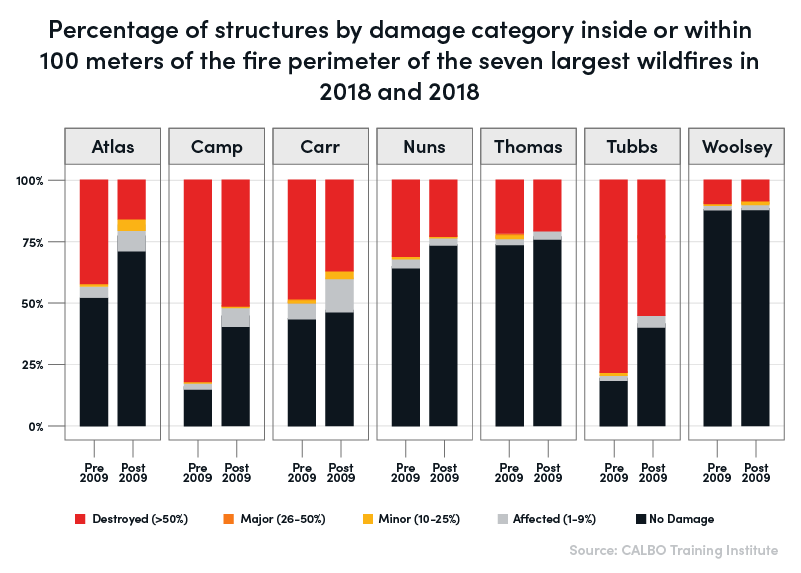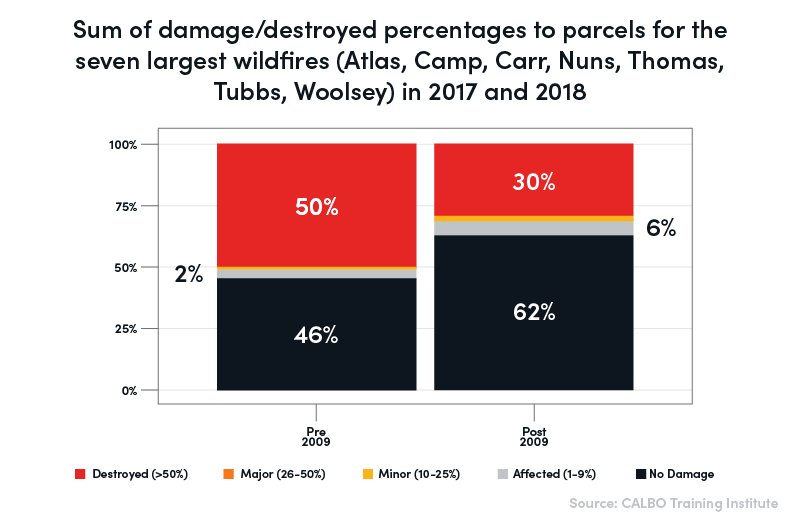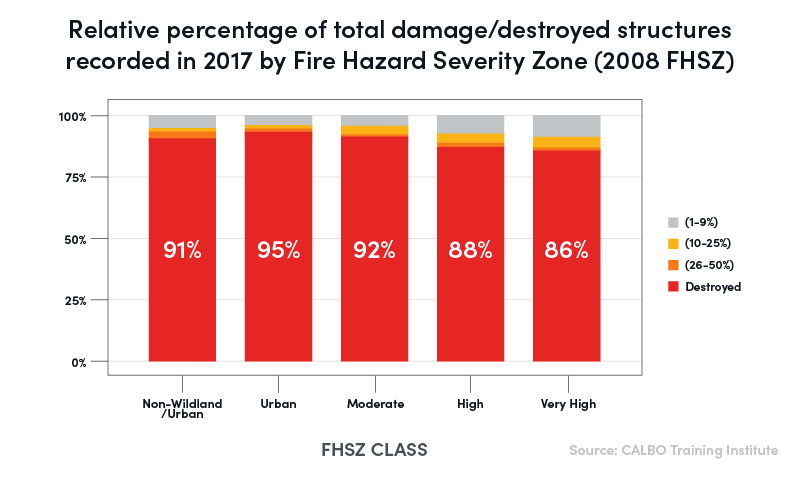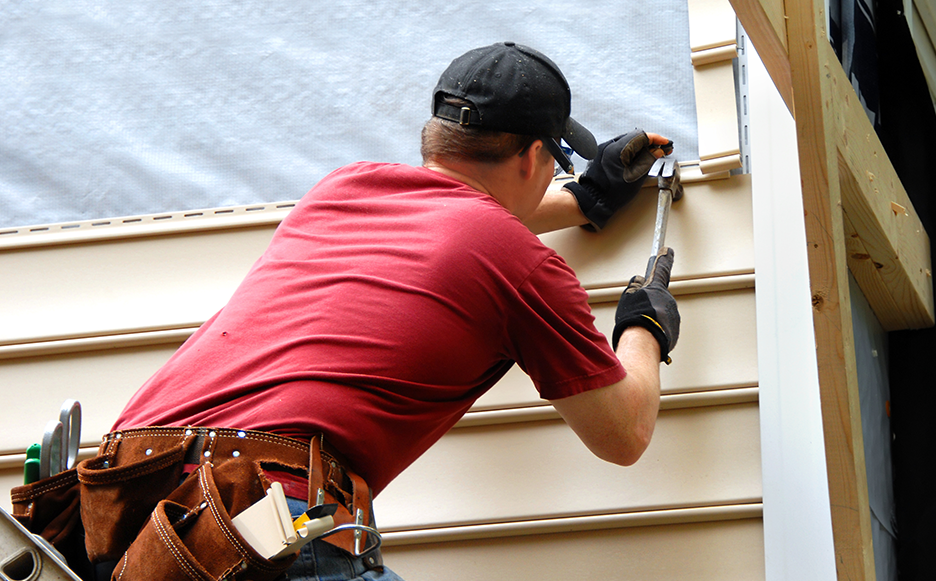According to a recent study from CAL FIRE (California Department of Forestry and Fire Protection), homes built with hardening standards are 40% less likely to be destroyed and 32% less likely to be damaged.
These findings support the importance of community education when it comes to wildfire home hardening.
The focus on wildfire home hardening has improved among new construction projects, particularly in California, but most residents don’t understand how they can prepare their existing homes for wildfires. This is where the biggest opportunity for education lies – providing your community with information about low-cost retrofitting and the basics of wildfire home exposure.
Check out the USDA Forest Service’s comprehensive guide, Living with Wildfire in Northwestern California, to get started with laying out your home hardening education program.

To launch a successful home hardening education program, it takes communities working together and strong, collaborative relationships among agencies.
Let’s talk about how your fire agency can get started on that path.
The Importance of Wildfire Home Hardening Education
Wildfire home hardening is about public safety and preservation of property. Simply put, these measures lessen structural damage when wildfires strike.
Home Hardening: The modification of building materials and design features of homes for wildfire resistance.

Because flying embers can destroy homes up to a mile away and are the main cause of wildfire destruction, educating your entire community about home hardening is critical.
Home hardening education and construction standards are becoming more and more common and there’s an increasing focus on hardening existing buildings. In fact, CAL FIRE is forming a state fire marshal sub-committee exclusively aimed at retrofitting regulations and future code requirements.
To encourage home hardening among existing buildings, fire leaders will need to rely on focused community education programs.

Educating Your Community
The mechanics of wildfire home hardening education are similar to other types of community education programs. Success is largely defined by engagement, and that engagement from the community relies on a few factors. Here are some tips to ensure your home hardening education makes a difference:
Make a measurable investment. As you plan your education program, be intentional with the budget. Think about the end-to-end process and your requirements at each stage. In today’s digital age, you will need more than an event space, email account, and instructors. Meaningful education requires technology solutions and digital communications so your agency can meet citizens where they are and where they listen.
Hold an outreach event in the beginning of the wildfire season. Timing is key when it comes to community education. For home hardening, it makes sense to kickstart your education program in the beginning (or right before) wildfire season. That way, it’s top of mind and reaches citizens when they’re thinking about safety and prevention.
Include the big picture in your education. Encourage property owners to invest time in knowing and reducing fire hazards. Everyone is safer when citizens know when, how, and why wildfires impact the community. Focus on home hardening, but make sure you also mention the basics of fire safety and prevention in your area.
Leverage technology. At a minimum, effectively educating your community will require a home for the information you’re sharing with them and multiple ways to distribute that information. If you’re also providing property assessments, you’ll also need tools for the field and office that simplify your assessment and follow-up process. Consider adopting a robust software platform that can support these efforts while creating the best possible experience for your staff and residents.
Lean on existing resources. As you begin or advance your conversations around home hardening education, consider these community tools from the USDA Forest Service:
- AIM (Action, Implementation, and Mitigation) by Coalitions and Collaboratives, Inc. The Action, Implementation, and Mitigation Program (AIM) is focused on increasing local capacity and support for wildfire risk reduction activities in high-risk communities. Participants in AIM get technical and financial support, becoming affiliate members of Coalitions and Collaboratives, Inc. (COCO).
- CMAT (Community Mitigation Assistance Team). CMAT is a resource that works with local partners to build sustainable mitigation programs focused on community fire adaptation actions. A CMAT works with communities at high risk of wildfire to analyze their programs and barriers, develop workable solutions to help mitigation, share best practices, and build successful partnerships.
- CPAW (Community Planning Assistance for Wildfire). Community Planning Assistance for Wildfire (CPAW) works with communities to reduce wildfire risk through improved land use planning. CPAW services are provided at no cost to the community, and include land use planning recommendations, hazard assessments, custom research, and training.
- Disaster Safety by the Insurance Institute for Business and Home Safety. Disaster Safety helps home and business owners protect their property from damage caused by wildfire and other natural disasters.
- FAC Net (Fire Adapted Communities Learning Network). The purpose of FAC Net is to exchange information, enhance the practice of fire adaptation, and work together to help communities live safely with fire. They offer a Fire Adapted Communities Self-Assessment Tool (FAC SAT) to help communities assess their level of fire adaptation and track their capacity to live safely with fire.
- Firewise USA®. Firewise USA® teaches people how to adapt to living with wildfire and encourages neighbors to work together and take action now to prevent losses.
- RSG! (Ready, Set, Go!). The Ready, Set, Go! program empowers fire departments to engage the residents they serve in wildland fire community risk reduction – providing tools and resources for fire departments to use as they help residents gain an understanding of their wildland fire risk.
- WFAP (Wildland Fire Assessment Program). The Wildland Fire Assessment Program (WFAP) is a joint effort by the U.S. Forest Service and the National Volunteer Fire Councilto provide volunteer firefighters and non-operational personnel with training on how to conduct assessments for homes located in the wildland-urban interface.
- WiRē. The Wildfire Research (WiRē) Center is a nonprofit organization that works with wildfire practitioners to seek pathways to create fire adapted communities, focusing on new approaches to integrating local social science into wildfire education and mitigation programs.
The sheer volume of initiatives fire leaders have to manage can make it hard to compartmentalize different priorities such as home hardening. But these measures are too important to not launch focused education programs. With the right plan and partners, your fire agency can help set the standard for community risk reduction.
Ready to learn about the modern approach to fire prevention management?
Request a demo of 3Di Fire Prevention today.

